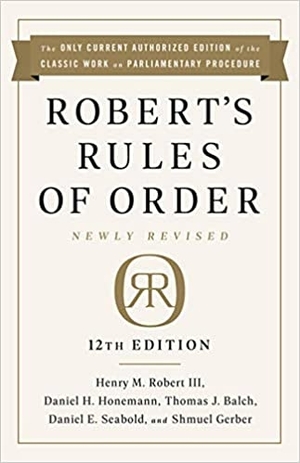Remedies for abuse of authority by the chair in a meeting
Updated August 26, 2021

Remedies for Abuse of Authority by the Chair in a Meeting
62:2 Making and Enforcing Points of Order and Appeals. In attempting to remedy any incorrect or abusive act by the chair at a meeting, the first step is for a member to raise a Point of Order as soon as the breach of the rules occurs.
62:3 For example, some important rules of parliamentary procedure are (a) that the chair must recognize any member who seeks the floor while entitled to it (see Section 42); (b) that after a member has properly made a motion that is not dilatory (see Section 39), the chair must either state the question on it, or else rule it out of order for a specified valid reason, require that the wording be clarified or be submitted in writing, or declare that it is not before the assembly for lack of a required second (see Section 4); and (c) that the chair cannot hurry through the proceedings so quickly as to deprive the members of their rights to debate and to introduce secondary motions (see Section 43:7).
62:4 So, if the chair ignores a member seeking the floor while entitled to it, ignores a properly made nondilatory motion, “gavels through” a motion in an improper attempt to cut off debate, or violates any other rules, any member may immediately raise a Point of Order.
62:5 To raise a Point of Order, a member rises and, without waiting to be recognized, immediately address the chair, saying, “I rise to a point of order,” or simply, “Point of order!” The chair must then ask the member to state the point’ and after the member does so, the chair is obligated either to rule whether the point is “well taken”—briefly stating the reasons for that ruling—or to submit the question to the assembly (see Section 23).
62:6 Immediately after the chair makes a ruling, any member who disagrees with it may then move an Appeal (unless another Appeal is already pending or an appeal would be dilatory because there cannot possibly be two reasonable opinions on the question). The member does this by rising and, without waiting to be recognized, addressing the chair, saying, “I appeal from the decision of the chair.” If the Appeal is seconded, the chair must state the question on it, clearly explain the exact parliamentary question at issue, allow any permissible debate, and put the question to a vote, as shown in Section 24.
62:7 These procedures enable the majority to ensure enforcement of the rules unless the chair fails to respond to and resolve the Point of Order, fails to respond appropriately to any Appeal, or fails to act in accordance with the assembly’s decision on the Appeal (or on a Point of Order submitted by the chair to the assembly).
62:8 If the chair ignores a point of order that is not dilatory, the member can repeat the point of order a second and third time and if the chair still ignores it, the member, standing in his place, can immediately put the point of order to a vote without debate. The question may be put as, “Is the point of order that …well taken?” If the point of order was that the chair improperly ignored another motion, the member may, instead of repeating the point of order, repeat the original motion, and if it is seconded and the chair still ignores it, may, standing in his place, put the ignored motion to a vote without debate.
62:9 Likewise, if the chair ignores an appeal appropriately made and seconded, a member can repeat the appeal and if, despite its being seconded, the chair ignores it again, the member can repeat it a third time and if it is again seconded but still ignored by the chair, the member can immediately, standing in his place, put the appeal to a vote without debate. The question may be put as: “Shall the decision of the chair be sustained?”
See also these posts about Point of Order and Appeal:
Keep the chair in line using Appeal
Point of Order and Appeal are the heart of democracy
Removing the chair during a meeting
The chair is not in charge of your meeting
When the chair is a bully or out of line

